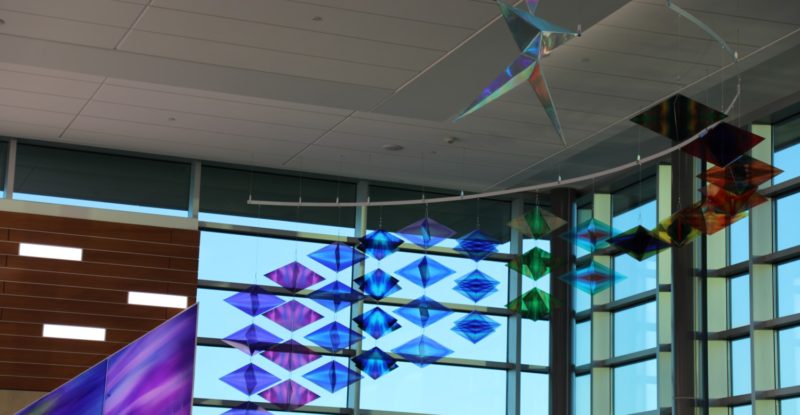The birthplace of Scotch Tape, Post-It Notes, Target, and the sprawling Mall of America, Minnesota might not be the first place you’d think of when it comes to innovative, larger-than-life contemporary art installations, but if Minneapolis-based multi-media artist Philip Noyed has anything to say about it, that’s all about to change.
“Many people think that Minnesota is ‘fly-over country’ … [and] probably assume that Minnesota art is all about landscapes, ducks, and crafts,” says Noyed who set out to prove the naysayers wrong with not just one but three large-scale art installations at Minneapolis-St. Paul International’s (MSP) new Terminal 2 gate expansion.
“When I first received the commission from Arts at MSP, I was given the wall for my art. I think that everyone believed that I would place four rectangle images on the wall [but] I really wanted the art installation to start 2D and then spring into 3D high above to symbolically show the magic of air travel,” says Noyed, joking that: “I’ve never been good at coloring in the lines.”
Inspired by Henri Matisse’s painting, Le Bonheur de Vivre (The Joy of Life), Noyed says his first installation, The Leap of Joy, was designed to help alleviate the stress and fear many passengers experience when flying.
“The Leap of Joy expresses the joy of travel and is meant to be iconic of air travel,” he explains. “It starts with a 25-foot long angle that follows the angle of an airplane taking off [and] from the angle springs an arc of free-floating diamond images that culminate in the Rainbow Leaper. The curve of the diamonds and Leaper are the only curves in the terminal and the curve brings a sense of freedom (of air travel) rather than being locked into a rectangle building.
“Also, the diamonds are free-floating and, with a breeze, move and activate the space. This installation speaks to the magic of air travel and quantum leaping forward into the future. The Leaper is intentionally rainbow colored and gender neutral as I wanted everyone to equally see themselves able to take The Leap of Joy whether in life choice or air travel.”
And while the second and third installations, The Aurora Borealis (Northern Lights) and The Rainbow Diamond and L’Etoile du Nord (The Star of the North), respectively, are based on more traditional Minnesota themes, they are no less spectacular in scope and meaning.
“The Aurora Borealis (Northern Lights) and The Rainbow Diamond is meant to bring the colors of the Northern Lights to life in the airport [and] L’Etoile du Nord is based on the Minnesota state motto, L’Etoile du Nord (The Star of the North) that was first adopted in 1861. [Using] rainbows to both be visually beautiful, but also to impart the meaning that anybody of any race, creed, nationality, or sexual orientation are welcome in Minnesota,” says Noyed.
“L’Etoile du Nord is 6 feet tall, made of aluminum and covered with holographic rainbow vinyl. Inside the star is a crystal prism that is lit so tiny light rainbows show on the ground below the star.”

The long rainbow colored piece on the wall in the background is called The Aurora Borealis (Northern Lights) and The Rainbow Diamond. Image: Philip Noyed
Already a huge hit with airport staff, Noyed notes that since the pieces have been installed the terminal has actually become a destination in itself for art-loving flyers.
“People I know book flights on airlines in the terminal [just] to see the art. So, the art makes the terminal a destination people want to go to see,” he says. “Art installations transform functional spaces into places of wonder and help diffuse [the] stress and anxiety of waiting in a confined space. While travel is magical, the process is arduous and stressful … even if you’ve always been a law-abiding person [and] the purely functional architecture and lack of colors in many airports combine to make a traveler feel small, processed, and uninspired. Art provides a sense of relief and joy and wonder once you have arrived at a terminal.”
“Travelers are curious [and] art in airports allows their curiosity to find something to experience and enjoy,” adds the artist. “My art moves and changes over time and I hope that people can sit in front of or under the art and lose themselves in the beauty of the color.
“I hope the art brings pause and zen space to travel to not be in a rush or feel the panic of being stuck for too long or not just be locked into a mobile phone … but to just gaze at the beauty and be transformed. I wanted to light up the airport … [and] have weary travelers leaving planes to walk the concourse to stop, look up, and exclaim: ‘Wow, I’m in Minnesota and, look! This art is fantastic!'”
Related Articles:













